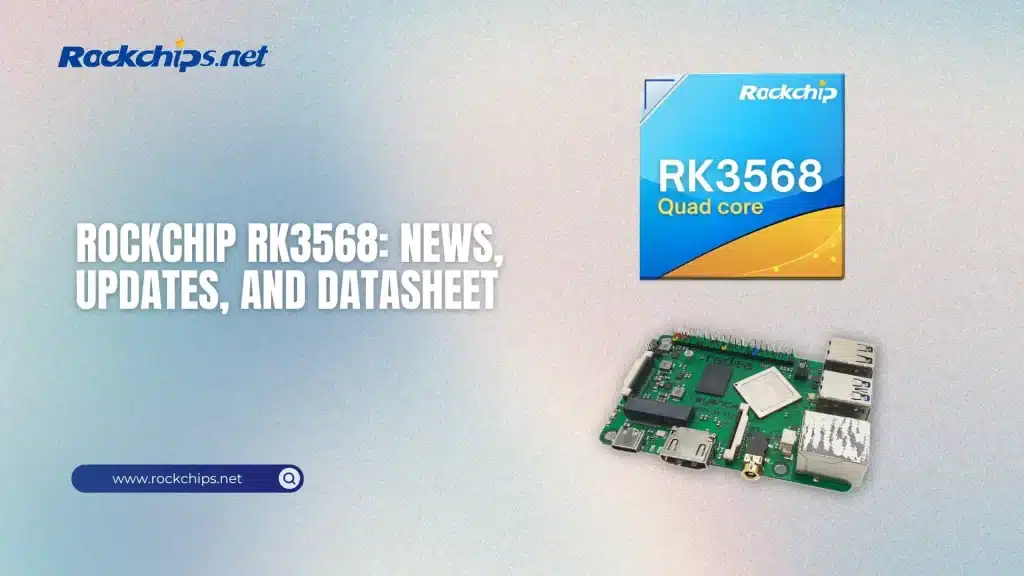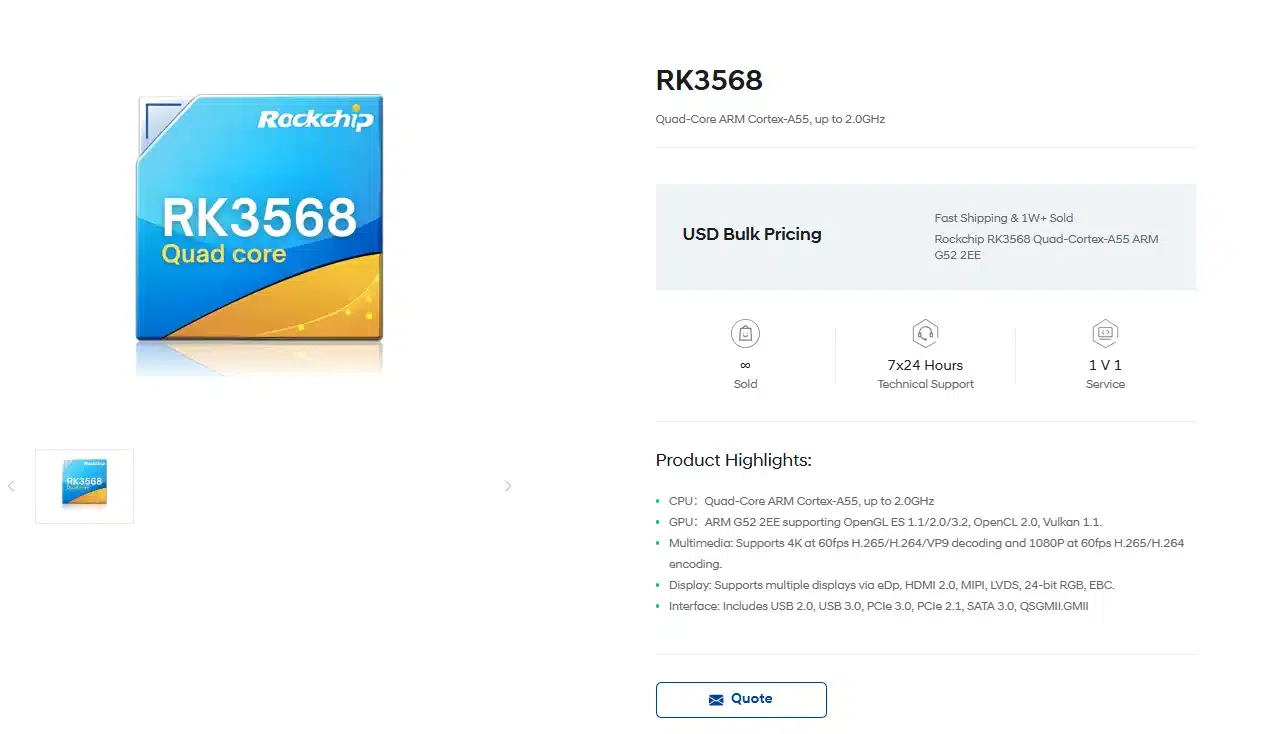
Introduction
Today, we write about the Rockchip RK3568, a versatile mid-range System-on-Chip (SoC) designed for industrial, IoT, and multimedia edge applications. It offers a balanced combination of power efficiency, flexible I/O options, and modern multimedia features, all while maintaining low cost and thermal output. This makes it a popular choice for applications such as single-board computers, media players, industrial controllers, and thin clients.In this article, we explore the key features of the RK3568, compare it to Rockchip’s higher-end RK3588 and the newer RK3688, and discuss the optimal product applications for the RK3568.
Also, read more about new RK3688 and RK3668: https://rockchips.net/rk3688-vs-rk3668/
At its core the RK3568 is a quad-core ARM Cortex-A55 CPU cluster (up to ~2.0 GHz in typical implementations), paired with an ARM Mali-G52 GPU and modest NPU support for lightweight AI inference. It supports modern memory types (LPDDR3/4/X, DDR3/4) and a robust set of multimedia accelerators – 4K video decode, 1080p encode, MIPI-CSI camera interfaces and multiple display outputs (HDMI 2.0/eDP/MIPI). The chip also exposes a broad assortment of peripheral interfaces that embedded designers expect: PCIe, USB (including USB 3.0 on many boards), Gigabit Ethernet, multiple UART/SPI/I²C channels and eMMC/SD storage support.
Those characteristics make the RK3568 a practical platform when you need reliable 4K playback, multi-camera input or industrial connectivity without the power/thermal complexity of flagship mobile SoCs.

Technical highlights (concise)
- CPU: Quad ARM Cortex-A55 up to ~2.0 GHz.
- GPU: ARM Mali-G52 (2-EE cores in common RK3568 variants).
- NPU: Entry-level NPU (approximately 1 TOPS in many firmware stacks) for lightweight inferencing.
- Multimedia: 4K60 H.265/H.264 decoding, 1080p60 encoding, 8MP ISP, JPEG, VPU and multi-display outputs.
- Memory & Storage: LPDDR3/4/4X or DDR3/4 support, eMMC 5.1, SD 3.0.
- I/O: PCIe, USB 3.0/2.0, SATA (board-dependent), Gigabit Ethernet, multiple UART/SPI/I²C.
RK3568 vs RK3588 vs RK3688 – Comparison Table
(Table sources: Rockchip and public SBC vendor datasheets and coverage).
When to choose RK3568
Choose the RK3568 when your product priorities are:
- Cost and thermal simplicity – RK3568 runs cooler and is more affordable than flagship chips.
- Reliable multimedia at the edge – 4K decode and multiple display outputs make it ideal for digital signage, kiosks and set-top applications.
- Industrial I/O and longevity – broad peripheral support and industrial-grade use cases (MIPI, multiple UARTs, GPIO, eMMC) suit embedded deployments.
- Moderate on-device AI – useful for simple vision tasks, anomaly detection or audio wake-word inference, but not for heavy neural networks.
If you need large-scale neural inference, 8K video, or high single-core performance (for emulation, gaming, large inference workloads), consider RK3588 or RK3688-class chips instead.
Software and ecosystem
Rockchip’s RK3568 benefits from an established Linux and Android ecosystem. Community boards and vendors such as Radxa, FriendlyElec, and numerous SBC manufacturers provide kernel patches, board trees, and Android images, which shortens development time for commercial products. Common frameworks (TensorFlow Lite, ONNX runtimes) can be used for lightweight inference after converting models to Rockchip’s preferred formats (RKNN, etc.).
Practical design notes
- Thermals: RK3568 is well-suited to fanless enclosures, but evaluate board-level thermal paths if you fit additional peripherals (M.2, SATA) that add heat.
- Memory choice: Select LPDDR4X for best power/performance balance; some designs use DDR4 for cost reasons.
- AI workflows: For computer vision, benchmark your model on a target RK3568 board early – the 1 TOPS NPU suits lightweight CNNs; larger models should be pruned, quantized or offloaded.
Conclusion
The Rockchip RK3568 sits in a practical sweet spot: a low-power, cost-effective SoC that delivers capable 4K multimedia, a useful set of industrial I/O and enough AI capability for many edge use cases. It is not a flagship gaming or heavy-AI processor like the RK3588 or the emerging RK3688 family, but that is precisely its strength – efficient, quieter, and easier to deploy in constrained enclosures and budgeted products. For embedded systems designers who prioritize thermal simplicity, stable multimedia playback and broad peripheral support, the RK3568 remains a solid choice.
Recent news about the Rockchip RK3568:
Avalue debuts 15.6-inch Rockchip Kiosk for smart service applications
Rockchip Driver Will Be Able To Drive 4K @ 60Hz HDMI Displays With Linux 6.12
Rockchip RK3568 Product Page:https://rockchips.net/product/rk3568/
Rockchip RK3568 Datasheet:https://rockchips.net/wp-content/uploads/2025/03/RK3568-Brief-Datasheet.pdf



